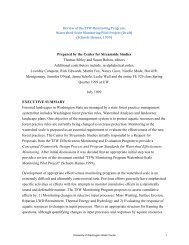Copyright 2012 Aileen M. Echiverri-Cohen - University of Washington
Copyright 2012 Aileen M. Echiverri-Cohen - University of Washington
Copyright 2012 Aileen M. Echiverri-Cohen - University of Washington
Create successful ePaper yourself
Turn your PDF publications into a flip-book with our unique Google optimized e-Paper software.
For the treatment modality and treatment response analyses, estimation <strong>of</strong> random effects<br />
modeling through SPSS version 18 was used to examine the difference in linear rates <strong>of</strong> change<br />
between treatment and response in inhibition scores from pre- to post-treatment.<br />
The random intercept model equation for treatment modality is<br />
yij (post-txt AB/PPI) = βoi (intercept; pre-txt AB/PPI) + β1i (slope; time)+ eij<br />
βoi (intercept) = Y00 + Y 01 (treatment modality : SER/PE) + uoi<br />
β1i (slope) = Y00 + Y 01 (treatment modality : SER/PE) + uoi<br />
The random intercept model for responder status is<br />
yij (post-txt AB/PPI) = βoi (intercept; pre-txt AB/PPI) + β1i (slope; time)+ eij<br />
βoi (intercept) = Y00 + Y 01 (responder status ) + uoi<br />
β1i (slope) = Y00 + Y 01 (responder status)<br />
For the mixed effects models, all available data from participants were used. In contrast<br />
to repeated measures that rely on a completer sample for analysis, mixed effects modeling uses<br />
all the available data where individuals missing values at various time-points are retained as long<br />
as there is one outcome point. Mixed effects modeling accounts for the within-subject correlation<br />
attributable to the repeated measures by either specificity, subject-specific effects (i.e., random<br />
effects), or modeling the errors to address the correlation <strong>of</strong> the repeated measures. The model<br />
estimated random effects for treatment and response and differential rates <strong>of</strong> change per<br />
treatment response between treatments were assessed by the treatment x time x response<br />
interaction. Hurvich and Tsai’s Criterion (AIC) was chosen over the -2 Restricted Log<br />
31
















